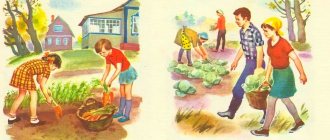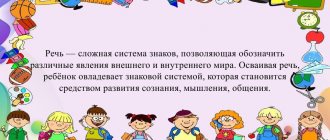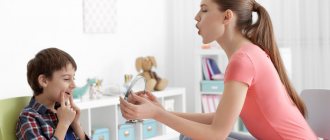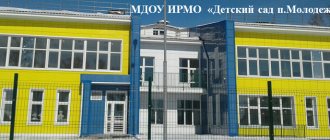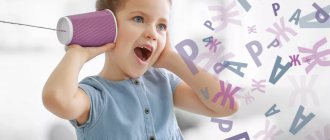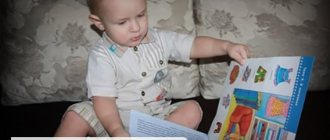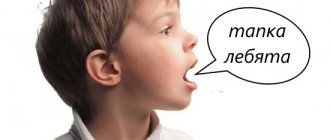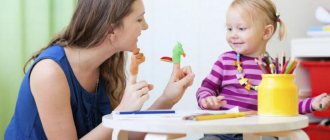- home
- Speech development
The main goal of raising a child at home and in kindergarten is his comprehensive development. He must move well, speak correctly, master hygiene skills, develop creatively, explore the world around him, and learn to overcome difficulties. Logorhythmics for children is a universal exercise containing motor exercises aimed at strengthening muscle tone, exercises for the development of articulation and speech breathing.
What is this
Volkova G.A., Shashkina G.R., Ekaterina Zheleznova studied the positive impact of rhythmic movements on speech together with the pronunciation of words and correct breathing in Russia. From their point of view, logorhythmics is a complex system of motor exercises aimed at eliminating speech anomalies in preschoolers and developing motor skills.
V.A. Gilyarovsky and N.A. Vlasova defined what logorhythmics is differently. In the mid-20th century, they studied the causes and methods of correcting logoneuroses. The main attention was paid to the word as a way to solve speech disorders. Rhythm and movement were given a secondary role. But they noted the usefulness of speech therapy rhythms for intellectual and aesthetic development.
In other words, logorhythmics is an activity that includes marching to rhythmic music, walking to a count, and running. Simultaneously with physical activity, the task is to control breathing, pronounce phrases, sing in a certain intonation, loudly or quietly, etc. Classes are held in an entertaining format, in a group or individually.
How does logarithmics affect the development of a 3-4 year old child?
Children who practice logorhythmics are more graceful, rhythmic, and able to move expressively, sing and speak. If the unity of all components is observed, positive changes will not be long in coming.
The influence of classes on children's development:
- The child learns to make the correct speech exhalation.
- An ear for music develops.
- Children become more dexterous, large and fine motor skills improve.
- Overly active kids calm down, become more diligent, and slow children become cheerful and active.
- Articulatory motor skills develop, and the pronunciation of sounds becomes clearer.
- Strength, agility and endurance are formed, children acquire beautiful posture.
These classes are especially important during the period of speech development, when any delay in speech development entails consequences that are difficult to eliminate.
Goals and objectives
The main goal of speech therapy rhythm for preschoolers is the correction and prevention of speech disorders by improving motor skills. Logorhythmics also has other related goals - health improvement, physical and spiritual education.
A lesson with elements of logorhythmics poses the following tasks for the teacher:
- Breathing development
- Correction of speech disorders
- Training in control of movements, speech, functioning of the organs of articulation and breathing
- Improving coordination
- Development of all types of memory, attention, spatial orientation
- Cultivating a sense of rhythm
- Reinforcing spatial concepts
- Introduction to spiritual values (music)
- Learning to sing and pronounce tongue twisters
- Expanding your horizons
- Increasing vocabulary
How are logorhythmics classes conducted with children 3-4 years old?
All logorhythmic exercises for children 3-4 years old are very simple and interesting; special training is not required to perform them. The adult shows and the child repeats after him. Children are not required to memorize and memorize the material; everything happens spontaneously. At first, a little help from an adult is required, but after a few lessons the kids can independently and accurately repeat the speech material.
In the video of the presentation of the song - a dramatization of the famous early childhood development teacher Zheleznova E.S.:
For a visible effect, you need to practice for at least 6-12 months, regularly conducting 2 classes per week. It is better to do this after a nap, although it all depends on the individual characteristics of the child. Children with stuttering and hesitation should practice logorhythmics at least 3-4 times a week.
Approximate structure of classes - exercises:
- Walking with tasks.
- For relaxation and tension.
- Articulation, breathing exercises.
- To develop attention and memory.
- Count from 1 to 10.
- Pronouncing the text of a poem with movements.
- On the formation of auditory attention.
- To develop a sense of rhythm, a sense of tempo.
- Singing.
- Finger gymnastics.
- Correction of incorrect pronunciation.
- To distinguish linguistic units.
Before conducting the classes, a little preparation is required - for each stage of the classes you need to select the appropriate soundtrack. It could be classics, children's songs, relaxation music, sounds of nature.
It is impossible to use a strictly defined lesson program; all lessons are adjusted to a specific child. If there are problems with motor skills - the proportion of corresponding exercises increases, sound pronunciation suffers the most - more time should be devoted to finger and articulatory gymnastics.
In no case should a child be scolded for failures, so that he does not lose interest in classes. It is better to abandon an unmastered exercise for a while, but then you still need to return to it.
Correction of speech disorders
Speech correction using speech therapy rhythms involves solving the following problems:
- Development of speech processes, their correction
- Creating motivation for speech activity
- Stimulation of phonemic activity
- Activating the dictionary
- Development of oral praxis
- Development of phonemic hearing
- Development of visual and auditory memory
- Teaching the rules of breathing during and without phonation.
Complex for children 3-4 years old
Logorhythmics in kindergarten for children over 3 years old may include the following complexes:
- Finger gymnastics
You need to stretch the fingers of both hands, make locks, depict boats, household items, etc. At the same time, poems are recited on various topics:
- Who sings what?
The cat sings a song: Meow! Meow! (children petting an imaginary cat).
The clock sings: Tick! So! (the handles represent ticking arrows).
Piglet grunts: Oink! Oink! (fingers make a patch - a circle).
The cabin in the river does not sing: Mmmmm! Mmmm! (press their lips, cover their mouth with their hands), etc.
- Mushrooms
Children stand in a row and walk through the forest to look for mushrooms. Massage your fingers without ceasing to walk. The teacher counts, creating a rhythm.
Top-top - five steps (children step to the rhythm of the poem), And in the basket there are five mushrooms (we count the fingers on the hands), Amanita is red (we stretch the index finger), It is very dangerous. And the second is a fox (we touch the next finger), a red pigtail. Pink ear (touch the ears) The third mushroom is the trumpet mushroom. And the fourth mushroom is the morel (tugging at the ring finger), a bearded old man. Well, what is the fifth mushroom? White! (put your hands in a lock and play with your fingers).
- Singing
Music lessons are used. Children learn breathing exercises. It is not necessary to sing songs; you can hum individual sounds, imitate animals, while doing physical exercises at the same time.
- Outdoor games to music
Logorhythmic exercises are performed with musical accompaniment. Words and movements are learned, attention and memory develop. You can use balls, passing them around to each other in a circle, chairs, toys to hide and quickly find, etc. Logorhythmics tasks for children 3-4 years old can be slightly complicated and used for games with the older, preparatory group.
Logorhythmic games for children 4-5 years old
By the age of 4-5 years, the final development of speech occurs. It is important to pay great attention to the pronunciation of sounds and strengthening the articulation of sounds. Therefore, speech therapy exercises at this age occupy a special place.
The horse runs tsk-tsk-tsk, (clicking movements of the tongue from the palate)
A bird chirps in a field. (same clicking noise but from teeth)
A friend is sitting on the bank (smile, teeth unclenched)
And catches a fish in the sea (they close and straighten their lips)
Breathing continues to develop. Speech breathing should be distinguished from the general one. You can perform exercises for alternating short and deep breathing:
Doll Masha wants to sleep. (inhale through your nose, exhale with a drawn-out sound “ahhhh”)
Let's sing her a song. (inhale through the nose, on one exhale repeat the syllable “la-la-la” three times)
Doll Masha fell asleep. (sniffle)
The right time for such exercises would be gymnastics after an hour of sleep. Together with general motor skills, fine motor skills are actively developing. It is worth adding acting skills to logorhythmic games and exercises, teaching children to get used to the role and operate with various phrases:
- I am a cheerful cockerel (inhale, exhale “ko-ko-ko”)
I have a comb. (shake head)
— I am a frowning turkey (inhale, exhale “pa-pa-pa”)
I'm looking for grains bale-bale (tilt my head as if pecking at the grains)
- I’m a mischievous horse (clicking tongue from the roof of your mouth)
Golden tail and mane (shake your head)
The expressiveness of movements should correspond to the emotional state of the hero. Children learn to manage their emotions and express them correctly. You can change the exercise words as you play. Let the children do it themselves, do not interfere with their imagination. When the children learn the words, let each of them do the exercises one by one.
Game 1
A good game would be to guess your classmates. It develops tactile sensations, general motor skills and rhythm: children stand in a circle, and one child in the center. He is blindfolded. The children begin to walk in circles. The teacher says “stop” and the children stop. The child in the center of the circle approaches one of the children in the outer circle and guesses who it is.
Game 2
A popular game for this age is “Sea Figure, Freeze!” Children take on the role, play actively, learn to listen to music and quickly respond to brake lights. Freezing in certain positions reinforces knowledge about the capabilities of your body.
Complex for children 5-6 years old
- Movement exercises It is better if the children themselves come up with movements to the poem that the teacher reads:
We will go to the forest today (children are walking), Who climbed the tree? (raise their heads up) Cuckoo? Cuckoo? (put hands to lips, repeat words) I’ll find you anyway
- Physical warm-up
Physical education to music. The poetic form of commands is used. Children gradually learn it by heart and pronounce it themselves.
The mouse ran quickly (we move one after another, slowly), The mouse wagged its tail (we repeat the movements of the animal), And dropped the egg (tilt down - lift up), Look, oh, it broke (we shake our heads, put our palms to our cheeks).
Logorhythmics in preschool educational institutions is used in any lesson: physical education, speech therapy, music. Teachers should pay attention to the pronunciation of auxiliary poems and words by children, and to the correct breathing of children during exercise.
5-6 years: continued work
When the child is 5-6 years old, logorhythmics classes move to a new level. The catalog of logorhythmic activities for children of this age should include active, outdoor games and exercises that require great physical effort. Walking now occurs with changes in directions and complex changes; It is useful to combine it with other activities (walking and singing or counting). Now logarithmics performs the following tasks:
- help replenish the stock of known words;
- improve fine motor skills;
- stimulate the development of creative abilities;
- improve speech and allow you to correct errors in the pronunciation of individual sounds;
- help to form correct posture.
At this age, children are actively preparing for school, so the exercises become more complex.
To prepare for writing, it is important to include in your classes exercises to develop fine motor skills, as well as self-massage (stroking, rubbing palms and fingers).
For example, you can play on the poem by F. Tyutchev:
It’s not for nothing that winter is angry (the child frowns and threatens with his index finger),
Its time has passed (rubs his palms contentedly),
Spring is knocking on the window (you need to tap your index finger on the other palm)
And he drives him out of the yard (the child actively waves his arms, gestures and facial expressions, driving away the winter).
It is also important now to develop a sense of rhythm, correct intonation, fluency of speech, teach the child emotionality in speech, and continue to work on breathing. To do this, it is useful to play children's musical instruments, sing sounds, syllables, tap the rhythm of poems with your feet, fingers or palms, and depict various emotions and feelings.
When preparing for school, it is also necessary to develop attention and concentration. To do this, you can, for example, confuse the child in games where he must repeat the movements of an adult (who periodically names one action and does another).
Vegetables
A 5-6 year old preschooler already has an idea about vegetables, so he can cope with the following exercises without any problems.
- “We chopped the cabbage!” - says the adult, shows the child the movement: bend your arms at the elbows, move them up and down alternately, as if chopping cabbage. The kid repeats.
- “We salted the cabbage!” – movement: bring your fingers into a handful and imitate the movement of pickling, moving your fingers.
- “We grated the cabbage!” – bend your elbows, press your fists one against the other and rub them together.
- “We squeezed the cabbage!” – bending his arms at the elbows, the baby, following the adult, begins to alternately clench and unclench his fists.
- “We did a great job!” - Let's clap for ourselves.
Advice
To make it easier for your child, you can first show him in the kitchen how to work with shredding cabbage.
Instead of cabbage, you can bake pancakes: recite a funny poem, making movements with your hands and clapping to the beat.
The dough was kneaded well, wow! Whoops! (the baby’s task is to unclench and clench his fists) The frying pans are hot, wow! Wow! (now make circular movements with both hands: palms move in a circle 2-3 times in each direction) Di-di, la-da, okay, let's bake pancakes (“bake pancakes” like this: clap your hands, holding them parallel to the floor, each time changing the “top” hand) Clap-slap, clap-slap, clap-slap, clap-slap! Lada - okay, okay, hot pancakes! (palms are placed in front of the face, you need to “draw” an imaginary semicircle with them to the left and right, and blow on them).
Animals
These exercises for preschoolers will not only help improve coordination, fine motor skills and speech skills, but will also help memorize the names of representatives of the animal world and the characteristics of their behavior.
The kids, following the adults, repeat simple poems about beetles, a bunny, a bear and make the necessary movements.
“How do beetles dance?”
Stomp-stomp with the right foot (children stomp one foot twice).
Top-top with the left leg (the same thing - the other).
Up, up our paws (children raise their hands up).
Who is tallest? (stand on tiptoes, try to stretch as high as possible without losing balance).
“Bunny”
Kids, following the adults, repeat the words of the rhyme and perform the movements:
The little bunny sits (children crouch),
Moves their ears (babies put their hands to their heads and make a movement that imitates the movement of long ears).
The little white tail is shaking,
He chatters his teeth.
I sat too long and got cold (children rub their hands over their arms, as if trying to warm up),
We need to warm up:
Let's clap our paws (kids clap their hands),
Let's stomp our feet (stomp on the spot).
That's good!
You can also use the well-known rhyme about a bear, “The clumsy bear walks through the forest.” Then the kids will have to do several exercises:
- imitate the gait of a bear;
- bend over as if to pick up a bump;
- Grab an imaginary lump with your palm and place it in your pocket.
Gradually, the children will learn rhymes and recite them without the help of a parent.
Advice
All sounds in the poem must be pronounced clearly so that the child has a positive example. Therefore, parents should practice.
The duration of the lesson is about 30 minutes twice a week. If there are problems, in agreement with the speech therapist, the number of training sessions can be increased.
New tasks
You can gradually complicate the tasks: read a poem of simple content to the children (for example, “Elephant” or “Little Goat” by Agnia Barto) and invite them to come up with movements that are appropriate in meaning. If difficulties arise, the parent can give advice and point them in the right direction.
Logorhythmics classes should become a useful habit, because, in addition to their obvious usefulness, they can give a child genuine pleasure, help him have fun and usefully spend his time. Parents should remember that there is no single training program that will suit everyone - the lesson is structured individually, depending on the child’s level of development. Logorhythmic exercises give positive results only after a long period, but the achieved effect can surprise even the most skeptical parents.
Recommendations for conducting classes
- Shape the lesson load according to the age and development level of preschoolers
- Give a lesson in the afternoon
- Change the topic of the lesson every week
- When selecting material, rely on lexical topics
- Use fairy tales and cartoons for speech and music exercises
- Exercise every day
- Accurately and clearly demonstrate to children the movements of their hands, body, and lips during phonation. Monitor the quality of assignments.
